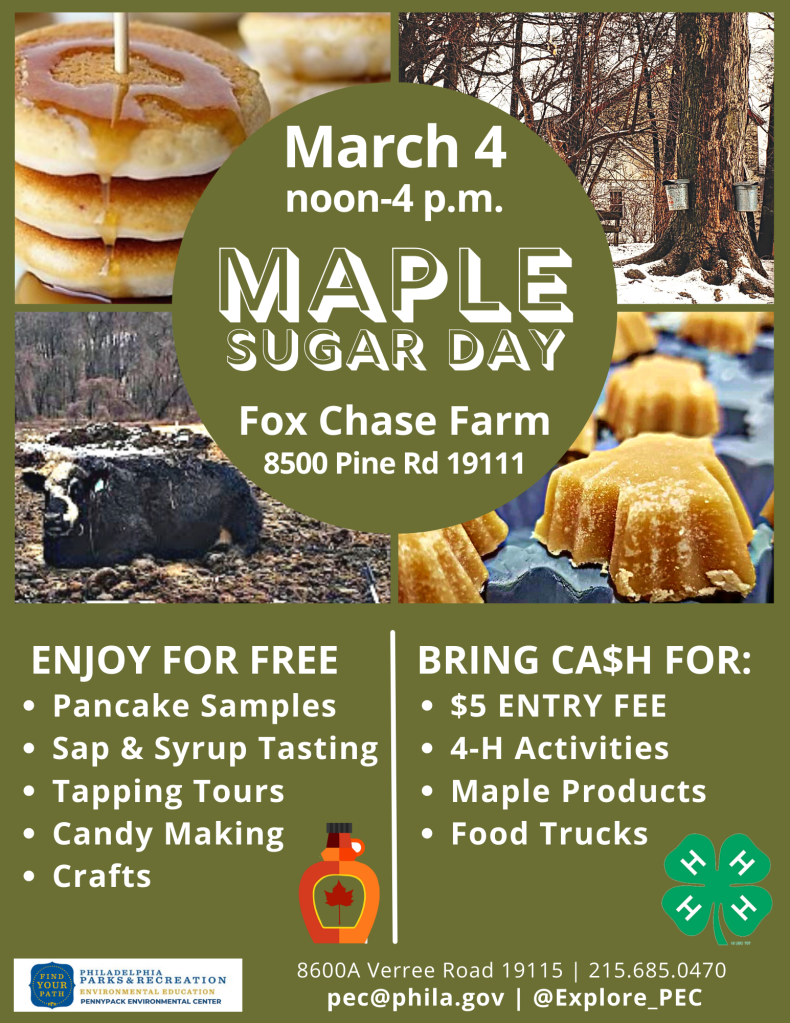Maple Sugaring in the City
by Christina N. Moresi, M.Ed. (She/They), Environmental Education Planner, Pennypack Environmental Center

As an environmental educator in Philadelphia, winter is a time of preparation for spring. We spend our days cleaning, organizing, planning, creating, greeting adventurous winter visitors, teaching, and dreaming of our sweet Maple Sugar Season.
Sugar season begins when the late winter nights are still freezing cold, but the days begin to warm. Once temperatures are consistently above freezing, and the trees begin to bud, we must pull the taps from the trees and say farewell to our sugaring days. Climate change has shortened our season, so we have four to six unpredictable weather weeks to introduce and engage as many children, families, and adults from in and around Philadelphia County in the sweet science of Maple Sugaring.
Our City streets and parks are full of maple trees, allowing us to dive deep into maple sugar lessons at our environmental centers, and even bring adapted fun to schools and recreation centers.
During Sugar Season, we take visiting schools and groups out to our maple trees and teach them how to: choose the best tree, drill and tap the trunk with a spile, collect the sap in a bucket, and boil the sap over the fire until it becomes sweet, sticky syrup.
Kids and adults alike are often surprised to see that the sap comes out of the tree looking more like water than syrup. The process of boiling the sap takes one or more days depending on the amount of sap in the evaporator. We boil until enough of the water content has evaporated, and the sap, now syrup, has reached 219 degrees Fahrenheit and is thick with amber coloring. On average, it takes about 40 gallons of sap to make one gallon of syrup.
Before we indulge in pancakes and real maple syrup, we give visitors a taste test to see if they can tell the difference between real maple syrup and flavored corn syrup. Kids often think the corn syrup is the real maple syrup, which does have a strong maple flavor. Adults are usually surprised to learn there is no maple syrup in pancake syrups. Despite the long list of ingredients, the word “maple” isn’t even on the bottle. Although lessons aren’t long enough for everyone to witness the entire process of sap to syrup, sampling syrup made last year on pancakes tastes just as sweet.
What I love most about Sugar Season, other than the syrup, is venturing out with the kids all bundled-up and hiking through the woods or on the farm. They are happy to be out of school, and I am happy they are outside. Our sugaring programs are not limited to schools and groups, but also include our annual Maple Sugar days that bring full-day activities, games, and demonstrations, including tapping trees, tasting syrups, sipping hot sap, snacking on pancakes, and sampling candy to three corners of Philadelphia and open to all.
Philadelphia’s environmental centers provide vital outdoor experiences while teaching and participating in the sustainable management of the country’s largest municipal park system. Research has shown that urban trees, farms, and natural areas are imperative to the improvement of citizens’ physical and mental health, the reduction of crime, and accessibility to fresh food, recreation, and exercise.
Maple Sugaring is a unique experience for our community that we have the privilege of stewarding in our urban forests, and the joy of creating programming that brings the magic of sugaring to everyone.
